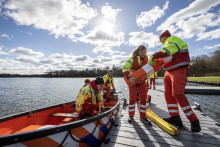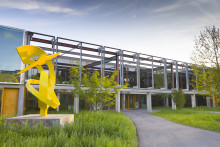Sunday morning at Het Rutbeek: a gentle spring sun replaces the night frost and Rescue Brigade Enschede is preparing for a series of practice drills. The life vests, rescue tubes, stretcher and emergency blankets are at the ready. The designated volunteer victim, Teun van Wershoven, searches for his spot while the brigade prepares for the drill scenario. ‘Where is our fake first aid kit?’, someone grumbles, as the hand-held radios are handed out. ‘Help! Help!’, someone is crying out. It’s two open-water swimmers shivering from the cold as they brave the Rutbeek lake and play a joke on the students. ‘Usually when they yell like that, it’s not all that bad,’ says Danny Verpoort, one of the most experienced members of Rescue Brigade Enschede.
Ether discipline
As the brigade splits up into pairs and a ‘CP’ - central post - team 1-13 encounters the victim. ‘A man in his twenties, about thirty metres away from the toilet block. Fell off his bike. Has no medication or underlying conditions and is responsive. Over.’ Immediately it becomes clear that there is no lack of radio discipline.
After consulting with ‘CP’, team 1-12 rushes in with the stretcher to transport the victim. The latter’s acting performance puts the brigade to the test: first he briefly loses consciousness, then he cries out as he is lifted onto the stretcher. But it’s no match for the brigade’s professionalism. With the victim wrapped in two emergency blankets, the team of four transports him to the central post on foot, all the while asking questions about his condition. First the inside leg, then the outside. Inside, outside. Inside, outside. A well-oiled machine.
'We all have a passion for helping people'
Eyes in the back of your head
It is time for the next drill: ground searching. Given the temperature, it is going to be a dry rescue today. As the brigade scours the beach, Van Wershoven walks over to talk to us, as a spectator this time. ‘I stayed out late last night, so I was quite comfortable just then,’ he says with a wide smile, before explaining the drill. ‘Under warmer conditions, we do the drill in shallow water. It’s a well-proven way of finding missing children or pieces of jewellery for example. Yes, you heard that right, children. One of the first things we learn during lifesaver training is that children can drown even in shallow puddles of water. Our more experienced lifeguards in particular have eyes in the back of their heads.’
That experience certainly doesn’t come out of nowhere, says Bram Bats. ‘We offer lifesaving training in the pool, to master the basic skills of rescue swimming. After that, you can go on to become a lifeguard, so you can provide emergency assistance on and around open water and supervise events. We even practised ice swimming last winter. And because there are so many international students at the university, we’re the only rescue brigade in the Netherlands that also offers its training courses in English.’

The odd ones out
All through the year, the brigade provides first aid, surveillance and water rescue services all over the country. Ranging from St Nicholas arrival parades in winter to the lifeguard station on Texel in summer. And from the Campus Challenge of survival run association Tartaros to big festivals like Zwarte Cross and Freshtival. Some of the 40 active members even practice lifesaving as a competitive sport. ‘We’re sort of the odd ones out in the swimming and water polo association, but what binds us together is that we want to do more than just swim laps,’ says Bats. ‘And as members of the rescue brigade, we can. We have mechanical engineers among us who like to tinker with the engine of the lifeboat, technical medicine experts who are passionate about first aid and civil engineers who know all about fluid dynamics. On top of that, we all have a passion for helping people.’
Friend group
As the only student rescue brigade in the Netherlands, there is no shortage of silly, student-like humour. This becomes apparent during the final drills of this cold Sunday morning, when the missing child Henk (8 years old) matches the following description: ‘orange face, orange hair and a horizontal white stripe across his chest’ - the exact characteristics of the rescue manikin with an underlying heart condition that is resuscitated moments later. Next, two plastic drowning victims, both named Jelle for the occasion, have to be rescued from the water by means of the life boat.
With both Jelles brought safely ashore, Bats further explains what makes this association within an association so special. ‘The humour is part of it, of course. I don't think you’ll find hungover volunteer victims at any of the other brigades, haha. The rule of thumb is: no joking around once the drill has started. But other than that, there is plenty of room for drinks, outings and other activities. Because of this, we have an incredibly close-knit group. It often feels more like a friend group than a rescue brigade.’







